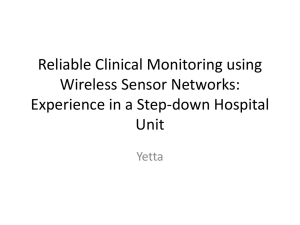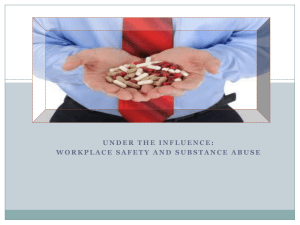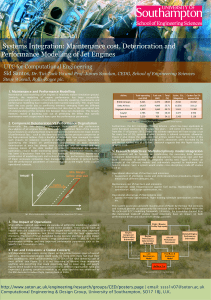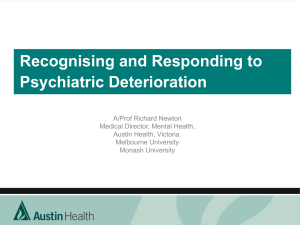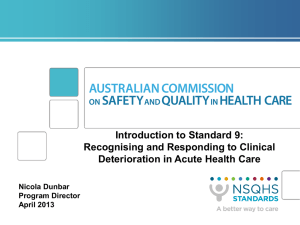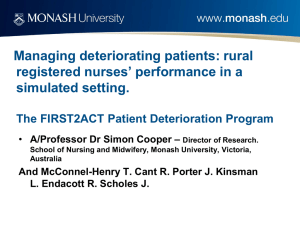Risk Factors for Clinical Deterioration on General Inpatient Units
advertisement
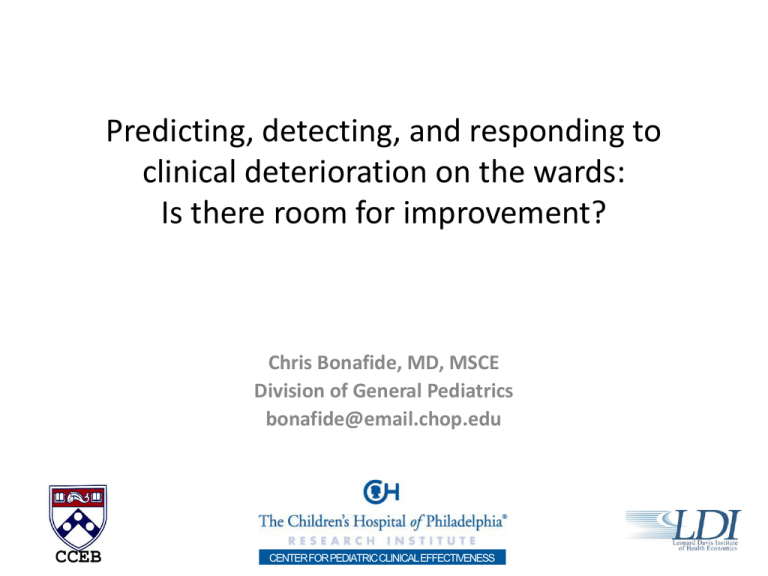
Predicting, detecting, and responding to clinical deterioration on the wards: Is there room for improvement? Chris Bonafide, MD, MSCE Division of General Pediatrics bonafide@email.chop.edu CCEB CENTER FOR PEDIATRIC CLINICAL EFFECTIVENESS Case Case • • • • • • • • High-risk patient Worsening vital signs New oxygen requirement Worsening labs Concerned staff Urgent interventions Delayed transfer to ICU Poor outcome Outline • What is clinical deterioration? • What are rapid response systems? • Who deteriorates? • Do vital sign abnormalities precede deterioration? • Once deterioration has been detected, are there barriers to calling for help? • Summary Outline • What is clinical deterioration? • What are rapid response systems? • Who deteriorates? • Do vital sign abnormalities precede deterioration? • Once deterioration has been detected, are there barriers to calling for help? • Summary What is clinical deterioration? Trajectories of Ward Hospitalization Death Cardiopulmonary Arrest Acute Respiratory Compromise D C Increased Care Needs Clinical Deterioration Vital Signworsening Changes •Acute of clinical status •On a trajectory toward arrest BC Routine Care Needs B A A Adapted from: Duncan H, Hutchison J, Parshuram CS. The Pediatric Early Warning System score: a severity of illness score to predict urgent medical need in hospitalized children. J Crit Care. Sep 2006;21(3):271-278. Outline • What is clinical deterioration? • What are rapid response systems? • Who deteriorates? • Do vital sign abnormalities precede deterioration? • Once deterioration has been detected, are there barriers to calling for help? • Summary What are rapid response systems? • Hospital-wide systems designed to prevent cardiac arrest and death in ward patients by: 1. Facilitating the identification of patients at risk 2. Deploying an expert team to the bedside of patients exhibiting signs of deterioration • Due to strong support from safety organizations 2005-2010, most US hospitals have some form of rapid response system – – CHOP HUP What are rapid response systems? Rapid Response System Afferent Arm (identification) Prediction of deterioration risk over time Prognostication tools Efferent Arm (response) Detection of active deterioration Standardized calling criteria Early warning scores Code blue team Medical emergency team Tools to supplement the clinical skills of nurses and physicians at the bedside Rapid response systems: mixed results Mortality rate better Cardiac arrest rate worse better Adults No significant reduction worse Adults 34% reduction Children Children 21% reduction 38% reduction Pooled Pooled Chan PS, Jain R, Nallmothu BK, Berg RA, Sasson C. Rapid Response Teams: A Systematic Review and Meta-analysis. Arch Intern Med. Jan 11 2010;170(1):18-26. Opportunities for rapid response system improvement 1. IDENTIFY a clinical profile of children at high risk of deterioration, and consider monitoring them more closely 2. DETECT deterioration more accurately using evidence-based tools 3. INTEGRATE detection into continuous physiologic monitoring systems 4. ELIMINATE barriers to calling for urgent assistance Outline • What is clinical deterioration? • What are rapid response systems? • Who deteriorates? • Do vital sign abnormalities precede deterioration? • Once deterioration has been detected, are there barriers to calling for help? • Summary Who deteriorates? Rapid Response System Afferent Arm (identification) Prediction of deterioration risk over time Prognostication tools Efferent Arm (response) Detection of active deterioration Standardized calling criteria Early warning scores Code blue team Medical emergency team Tools to supplement the clinical skills of nurses and physicians at the bedside 25 25 5 10 15 20 Hours after admission 0 5 10 Percent 15 20 Age 0 Percent CHOP deterioration data 0 2 4 6 8 10 Age 12 14 16 18 0 24 48 72 96 120 144 168 hours after hospital admission 192 216 240 Development of a predictive score to identify pediatric inpatients at risk of clinical deterioration • Objective: To develop a predictive score for deterioration using non-vital sign risk factors – Intended use: identifying high-risk children who should be intensively monitored • • • Design: Case-control study Setting: The Children’s Hospital of Philadelphia Patients: – Cases (n=141) were children who deteriorated while receiving care on a non-ICU inpatient unit – Controls (n=423) were randomly selected • • • Exposures: Complex chronic conditions, other patient factors, and laboratory studies in the 72h before deterioration Outcome: Clinical deterioration, defined as cardiopulmonary arrest, acute respiratory compromise, or urgent ICU transfer Analysis: Multivariable conditional logistic regression Predictive score Final multivariable conditional logistic regression model for clinical deterioration. Predictor Adjusted OR (95% CI) p-value Regression Coefficient (95% CI) Scorea Complex Chronic Conditions Epilepsy 4.36 (1.94-9.78) <0.001 1.47 (0.66-2.28) 2 Congenital/genetic defects 2.13 (0.93-4.89) 0.075 0.76 (-0.07-1.59) 1 History of any transplant 3.01 (1.31-6.92) 0.010 1.10 (0.27-1.93) 2 Percutaneous or naso-enteral tube in preceding 24 hours 2.14 (1.29-3.55) 0.003 0.76 (0.25-1.27) 1 Age <1 year 1.86 (1.03-3.35) 0.038 0.62 (0.03-1.21) 1 Blood culture sent to lab in preceding 72 hours 5.81 (3.29-10.28) <0.001 1.76 (1.19-2.33) 3 Hemoglobin <10g/dL in preceding 72 hours 3.01 (1.79-5.06) <0.001 1.10 (0.58-1.62) 2 Other Patient Factors Laboratory Studies Abbreviations: CI, confidence interval; OR, odds ratio. aScore derived by dividing regression coefficients for each covariate by the smallest coefficient (age<1 year, 0.62) and then rounding to the nearest integer. Score ranges from 0 to 12. Results Risk strata and estimated probabilities of deterioration. Risk stratum Very low Low Intermediate High Scores 0-2 3-4 5-6 7-12 SSLR (95% CI) 0.39 (0.29-0.51) 1.18 (0.85-1.64) 2.63 (1.74-3.96) 96.00 (13.24-696.17) Abbreviations: CI, confidence interval; SSLR, stratum-specific likelihood ratio. aCalculated bSome using an incidence (pre-test probability) of deterioration of 0.15%. individual scores above 7 include only cases. Probability of deteriorationa 0.06% 0.18% 0.39% 12.60% Conclusions • Identified a group of risk factors that may be useful to assess on admission and periodically during the hospitalization to identify patients who deserve more intensive monitoring for signs of deterioration Next steps 25 • Domain validation and updating of score parameters using patients at the time of admission from the emergency department to predict deterioration in the first 12 hours 15 10 5 0 Percent 20 Hours after admission 0 24 48 72 96 120 144 168 hours after hospital admission 192 216 240 Outline • What is clinical deterioration? • What are rapid response systems? • Who deteriorates? • Do vital sign abnormalities precede deterioration? • Once deterioration has been detected, are there barriers to calling for help? • Summary Do vital sign abnormalities precede deterioration? Rapid Response System Afferent Arm (identification) Prediction of deterioration risk over time Prognostication tools Efferent Arm (response) Detection of active deterioration Standardized calling criteria Early warning scores Code blue team Medical emergency team Tools to supplement the clinical skills of nurses and physicians at the bedside Pediatric Early Warning Scores • Combine intermittent vital sign values into a manually-calculated composite score • • • • Monaghan’s Paediatric Early Warning Score Haines’ Paediatric Early Warning Tool Parshuram’s Bedside Paediatric Early Warning System Score Edwards’ Cardiff and Vale Paediatric Early Warning System – Abnormal parameters based on expert opinion – Not adequately validated – Variations of the scores above used widely What is abnormal for hospitalized children? • Age-based reference ranges for HR and RR – not evidence-based – vary widely between sources • Better evidence exists for normal blood pressure in healthy children, but these ranges have not been evaluated in-hospital Development of “expected” vital sign curves • Objective: To develop expected HR, RR, SBP, and DBP curves using data from hospitalized children, to serve as the basis for: – In-hospital reference ranges – Vital sign-based early warning score development • Design: Retrospective cohort study • Setting: Cincinnati Children’s Hospital • Data Source: Manually documented vital signs in EHR • Patients: – Admissions to non-ICU inpatient units in 2008 (n=11,789) – Excluded age >=18, DNR or death during admission, LOS>1 year – Excluded vital sign observations that were physiologically implausible • HR 0-300 = plausible • Analysis: generalized additive models for location scale and shape (GAMLSS) using BoxCox power exponential distribution Vital sign data: HR n=542,766 obs First set of curves Vital sign data: HR n=542,766 obs 79 high HR values from one patient hospitalized for 56 days 16 low HR values from one patient within a 4hour window HR 57 56 10 33 28 46 RR 173 133 49 119 115 132 Single observations in patients who survived to discharge and were not DNR 150 150 100 100 50 50 hr, numeric hr, numeric 100 80 60 40 0 200 400 time difference admission to observation as numeric 50 100 time difference admission to observation as numeric 5 10 15 20 time difference admission to observation as numeric 0 500 1000 1500 2000 time difference admission to observation as numeric 150 20 40 60 80 time difference admission to observation as numeric 100 0 50 100 time difference admission to observation as numeric 150 0 500 1000 time difference admission to observation as numeric 1500 100 150 100 hr, numeric 100 600 50 0 0 0 50 50 hr, numeric 100 150 150 200 25 200 40 0 50 hr, numeric 100 50 0 0 50 hr, numeric 100 0 150 10 20 30 time difference admission to observation as numeric 0 150 0 40 0 0 20 0 10 20 30 time difference admission to observation as numeric 150 0 2500 Addressing documentation error • Used RR as a data integrity check – RR documented simultaneously – RR<HR – RR physiologically plausible (5-120) Addressing Documentation Error Single patient spikes still problematic Ascertainment bias issues • Clustering of extreme values – In a single patient experiencing an acute event over a short time – In a single patient with abnormal baseline values over the course of a long admission • Addressed by: – Randomly selecting one HR from each 6-hour window of each patient’s admission – Randomly selecting up to 10 of these values for each admission Data for curve generation Next steps for curve analysis • Developing second set of curves with data integrity steps in place • Validation using CHOP sample • Will then use the z-scores for these curves to develop early warning score using vital sign data from case-control study Opportunities to integrate detection tools into physiologic monitoring? • Most inpatients are connected to physiologic monitors • Alarm parameters are set manually and adjusted as needed • CHOP monitors generate ~20,000 alarms/day • Nurses are automatically paged with a generic message for each of these alarms • Can we identify and filter out false alarms? • Can physiologic data be combined to generate multiparameter alarms? • Can alarms be adaptive to recognize important withinsubject changes that may not reach pre-set alarm parameters? HUP ICU Smart Alarms Project • Evaluates HR, RR, SpO2, Skin Temp continuously • Evaluates BP measured at periodic intervals using a cuff • Compares monitored values to a model of normality generated using neural networking methods applied to a training data set • Variance from data set used to evaluate probability that vital signs are normal • Generates a status index ranging from 0 (no abnormalities) to 10 (severe abnormalities in all variables) • Short-term median filtering for noise removal • Historic filtering for coping with missing parameters http://www.obsmedical.com/products/hospital-patient-monitoring/visensia-central-station Outline • What is clinical deterioration? • What are rapid response systems? • Who deteriorates? • Do vital sign abnormalities precede deterioration? • Once deterioration has been detected, are there barriers to calling for help? • Summary Qualitative evaluation of the mechanisms by which rapid response systems impact patient safety • Objectives: • To qualitatively determine how the identification and response components of rapid response systems impact nurse decision-making relevant to patient safety • To identify barriers to recognizing and responding to clinical deterioration that exist despite rapid response system implementation • Design: Qualitative study using semi-structured interviews • Setting: CHOP • Subjects: 27 nurses who care for children on non-ICU units • Data Collection and Analysis: • Audio recorded and transcribed interviews • Coded using constant comparative methods • Analyzed using a grounded theory approach Theme: Despite implementation of an open access medical emergency team, some barriers to calling for urgent assistance still exist. • Some nurses doubted their own ability to recognize deterioration. • Some nurses were hesitant to call for help for fear of being viewed as inadequate or unable to handle a difficult situation. • While most nurses reported a collaborative working relationship with physicians, issues of hierarchy were discussed, with nurses reporting that physicians sometimes disagreed with their assessment of the need for urgent assistance. This prevented or delayed some nurses from calling the medical emergency team. Barrier examples • • Medical nurse, 5-10 years experience: We had a child on BiPap who we had tried everything to keep his sats up… and literally nothing was working. At the 6:00 hour both me and the charge nurse were like, to the resident, we said, “We need you to do something. Can we just call the CAT team for a second opinion? Just something, maybe change the CPAP, just something.” We have had issues with this one particular one who insisted that, “He just needs some chest PT.” I insisted that I was doing chest PT for five straight hours now and I was doing it hard. I was doing it good. We just kept meeting resistance… • • Medical nurse, 2-5 years experience: I felt very uncomfortable with the patient… I was in there doing blood pressures and I don’t even think I got to write them all down. I was doing them so frequently. She was very sick. I felt resistance from every member of the team. That made me hesitate to speak up. I did speak up several times, but then I stopped. I spoke up so many times saying, “This is not okay. I am extremely concerned.” Multiple times, but I never said, “No, that’s it.” I just didn’t take that last step… Next steps for qualitative study • Stratify analysis by nursing characteristics • Expansion to physicians to enable direct comparisons with nursing themes Outline • What is clinical deterioration? • What are rapid response systems? • Who deteriorates? • Do vital sign abnormalities precede deterioration? • Once deterioration has been detected, are there barriers to calling for help? • Summary Summary of opportunities for rapid response system improvement 1. IDENTIFY a clinical profile of children at high risk of deterioration, and consider monitoring them more closely 2. DETECT deterioration more accurately using evidence-based tools 3. INTEGRATE detection into continuous physiologic monitoring systems 4. ELIMINATE barriers to calling for urgent assistance Thank you • Mentors/Collaborators – – – – – – – – – – – – – Ron Keren John Holmes Vinay Nadkarni Russell Localio Richard Landis Bob Berg Kathryn Roberts Fran Barg Chris Feudtner Alex Fiks Rich Lin Carrie Daymont Pat Brady • Research Assistants – – – – – Emily Huang Kathleen McLaughlin Shelby Drayton Annie Chung Duy-An Ho
